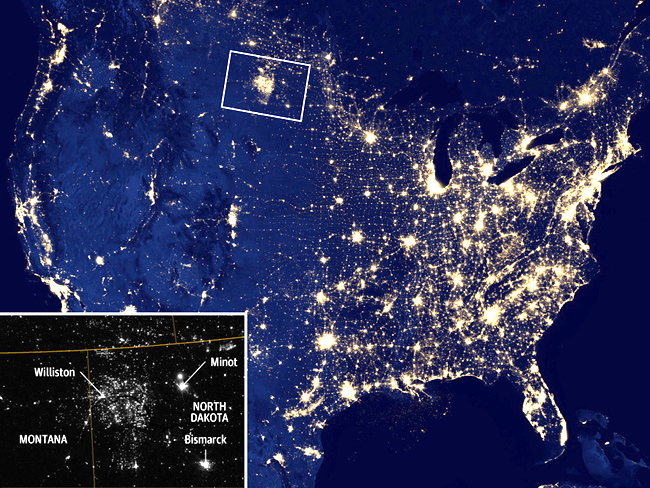Why Boston Pays High Prices For Electricity
Natural gas prices vary widely — not just seasonally (electricity generation for summer air conditioning and winter heat create a familiar wave pattern to prices) but also regionally. It’s well known that natural gas prices are higher in many parts of the world than in the U.S. Probably less well knownn is the regional differences that occur within the 48 contiguous states.
The starkest contrast must be between North Dakota, where gas is flared because the infrastructure is not in place to move it, and New England where insufficient infrastructure exists to service peak periods. This night-time satellite image from NASA shows the many illuminated metropolitan areas, but the area denoted by the rectangular box is how the flaring of natural gas in the Baaken Shale in north Dakota (a very non-metropolitan area) appears. The excess methane is produced along with crude oil, and for now there is no place for it to go. The CO2 produced by flaring is the equivalent of 1 million new cars on the roads. Regulations are already being tightened; the amounts flared have fallen from 35% of methane produced in 2013 to 26%, and the goal is to reduce it further to 15% or lower by 2020.
Meanwhile, as everybody living in northern states knows, this has been another bitter winter. Boston had to suspend local regulations in order to dump snow into Boston harbor, since they had run out of places to put it. Less well known is that the price of natural gas in New England reached $19 per MBTU recently. This compares with spot prices of around $3 at the Henry Hub. The price in Willliston, ND, as shown by the flaring in the satellite photo, is zero.
New England’s energy infrastructure is widely acknowledged to be inadequate to the task. Some of the problems are self-inflicted, including a reluctance to invest in fossil fuel infrastructure in the hope of more “green” alternatives. Kinder Morgan’s (KMI) proposed pipeline from Pennsylvania has run into heavy local opposition, even though 45% of the region’s electricity is produced by burning natural gas. There’s also been a reluctance to make greater use of electricity produced across the border by Ontario Hydro.
New England suffers from other challenges of geography though. Situated on the coast, it is not on the way to anywhere which means any pipeline built is going to stop there. And the region suffers from extreme cold which causes spikes in energy usage, as we’ve seen recently.
This does highlight the ongoing need for new energy infrastructure though. Abundant supplies of natural gas are in North Dakota as shown, and (more relevant for Boston) also in Pennsylvania. It hasn’t been as easy as you might think for New Englanders to benefit from this reasonably accessible supply, but there are plans in place to resolve the bottleneck. Spectra Energy (SE) has an initiative called Access Northeast which is designed to supply more gas at affordable prices for electricity generation. The governors in the region have also been working together seeking an improved situation.
The point of this is that the global price of oil has very little to do with the need for improved peak supply of gas in Boston. Companies like KMI and SE are pressing ahead with these and many projects where traditional concerns such as regulatory approvals, easements, construction costs and financing are more important than the price of oil. For cold Bostonians paying temporarily high prices for electricity, such improvements can’t come fast enough. We are invested in KMI and SE.

